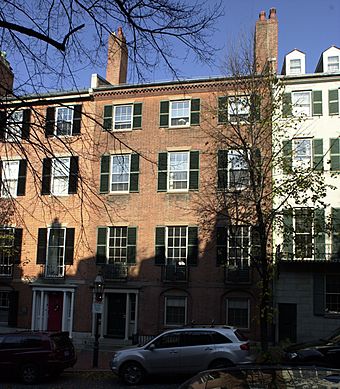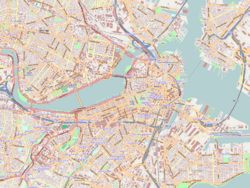Samuel Gridley and Julia Ward Howe House facts for kids
|
Samuel Gridley and Julia Ward Howe House
|
|
|
U.S. Historic district
Contributing property |
|
 |
|
| Location | 13 Chestnut St., Boston, Massachusetts |
|---|---|
| Area | less than one acre |
| Built | 1804 |
| Architect | Bulfinch, Charles |
| Architectural style | Georgian |
| Part of | Beacon Hill Historic District (ID66000130) |
| NRHP reference No. | 74002044 |
Quick facts for kids Significant dates |
|
| Added to NRHP | September 13, 1974 |
| Designated CP | October 15, 1966 |
The Samuel Gridley and Julia Ward Howe House is a historic home in the Beacon Hill neighborhood of Boston, Massachusetts, United States. It's a special place because of its connection to Julia Ward Howe and Samuel Gridley Howe. They were a famous couple who worked hard to make society better.
The Howes lived in this house from 1863 to 1866. It was likely designed by a well-known Boston architect named Charles Bulfinch. In 1974, the house was recognized as a National Historic Landmark. Since 2016, it has served as a temporary home for the British Consul General to New England.
Contents
What Makes This House Special?
This building is a four-story house made of brick. It's one of three similar homes called "Swan Houses." A wealthy widow named Hepzibah Swan had them built for her daughters between 1804 and 1805.
Many people believe the famous architect Charles Bulfinch designed these houses. The house has a classic Georgian style. You can see this in its recessed front doorway. The windows on the first floor are set back in arches. There are also decorative wrought iron railings on the second-floor windows.
Who Were Samuel Gridley and Julia Ward Howe?
Samuel Gridley Howe (1801–1876) was a doctor. He was one of the first people to strongly support those with physical disabilities. He helped start the Perkins School for the Blind and led it for 44 years.
In 1843, he married Julia Ward (1819–1910). She was the daughter of a rich banker from New York City. Together, they became very important in social reform movements. These movements aimed to improve society in the mid-to-late 1800s.
Fighting for Change
The Howes worked hard for many important causes. They strongly supported the end of slavery. They even led the Boston Vigilance Committee. This group helped people escape slavery in the 1850s.
Julia Ward Howe became nationally famous for writing "The Battle Hymn of the Republic." She wrote this famous song not long after moving into this house. She was also a strong supporter of women's right to vote. She helped organize many reform movements that continued long after her time.
The Howe Family's Homes
After they got married, the Howes lived for many years at a house called "Green Peace" in South Boston. That house is no longer standing today.
Later, they lived at several different addresses in Boston. This house on Chestnut Street is considered their most important home. It was named a National Historic Landmark in 1966. It was also added to the National Register of Historic Places in 1974. The house is a private residence and is not open for public visits.




